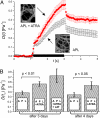The regulatory role of cell mechanics for migration of differentiating myeloid cells
- PMID: 19717452
- PMCID: PMC2747182
- DOI: 10.1073/pnas.0811261106
The regulatory role of cell mechanics for migration of differentiating myeloid cells
Abstract
Migration of cells is important for tissue maintenance, immune response, and often altered in disease. While biochemical aspects, including cell adhesion, have been studied in detail, much less is known about the role of the mechanical properties of cells. Previous measurement methods rely on contact with artificial surfaces, which can convolute the results. Here, we used a non-contact, microfluidic optical stretcher to study cell mechanics, isolated from other parameters, in the context of tissue infiltration by acute promyelocytic leukemia (APL) cells, which occurs during differentiation therapy with retinoic acid. Compliance measurements of APL cells reveal a significant softening during differentiation, with the mechanical properties of differentiated cells resembling those of normal neutrophils. To interfere with the migratory ability acquired with the softening, differentiated APL cells were exposed to paclitaxel, which stabilizes microtubules. This treatment does not alter compliance but reduces cell relaxation after cessation of mechanical stress six-fold, congruent with a significant reduction of motility. Our observations imply that the dynamical remodeling of cell shape required for tissue infiltration can be frustrated by stiffening the microtubular system. This link between the cytoskeleton, cell mechanics, and motility suggests treatment options for pathologies relying on migration of cells, notably cancer metastasis.
Conflict of interest statement
Conflict of interest statement: J.G. holds a patent on the optical stretcher technique and consults on its potential applications.
Figures





References
-
- Duffy MJ, McGowan PM, Gallagher WM. Cancer invasion and metastasis: Changing views. J Pathol. 2008;214:283–293. - PubMed
-
- Even-Ram S, Yamada KM. Cell migration in 3D matrix. Curr Opin Cell Biol. 2005;17:524–532. - PubMed
-
- Friedl P, Weigelin B. Interstitial leukocyte migration and immune function. Nature Immunol. 2008;9:960–969. - PubMed
Publication types
MeSH terms
Substances
LinkOut - more resources
Full Text Sources
Other Literature Sources

